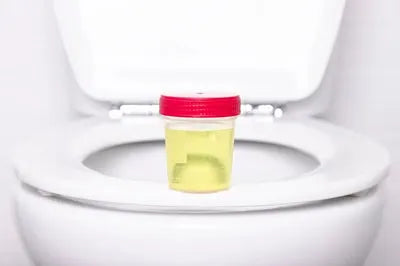Foamy urine in women is more common than you would think. It can seem alarming, but before you panic, let's break down what’s really happening. It’s usually not as scary as it looks. But it’s worth paying attention to, just in case.
So, what’s causing foamy urine in women? And how do you treat it? Let’s dive in to get the facts right.
Foamy Urine Causes in Women
There are several reasons why your urine might appear foamy. Some are harmless, while others could indicate an underlying health condition. Let's explore a few of the most common foamy urine causes:
-
Peeing With Too Much Force
Sometimes, foamy urine in women is just a result of urinating too fast. When you’ve been holding it all day and finally get to the bathroom, its pressure is too high. You release a strong stream of urine, and the air gets trapped, causing bubbles that could look like foam.
-
Dehydration
Have you been skipping water? If you’re dehydrated, your urine becomes more concentrated. This can cause foaming. It’s like making instant coffee with too little water. Everything is a bit thicker and more intense. When there’s less water in your body, the proteins and waste products in your urine are more concentrated. This can sometimes lead to foamy urine in women.
-
Proteinuria
A condition in which there's too much protein in your urine is known as proteinuria. This condition is a sign that your kidneys aren't filtering properly. It could indicate a kidney disease of any stage. The only way to confirm the disease is by visiting a doctor. They will run the tests and determine whether your foamy urine is a sign of concern. Until then, try not to freak out.
-
Urinary Tract Infections (UTIs)
A foamy urine could be a sign that you have a UTI. UTIs are famous for causing symptoms like frequent urination, burning sensations, or cloudy urine, but sometimes, foaminess comes along for the ride, too. Bacteria in your urinary tract can interact with the urine to cause bubbles. So, it’s something to keep in mind if you’re also experiencing other UTI symptoms.
Many people believe that wearing diapers increases your chances of UTIs. While that’s true to some extent, using diapers made with anti-bacterial properties will reduce the risks. Friends UltraThinz Slim Fit Dry Pants for Women lock in the urine smell and protect against bacterial infections.
Also Read: What Causes Foamy Urine?
Foamy Urine Treatment In Women
If you're concerned about foamy urine in women, it's essential to consult with a healthcare professional. They can help determine the underlying cause and recommend appropriate treatment. Here are some general foamy urine treatment approaches:
-
Hydrate, Hydrate, Hydrate!
The golden rule is to drink enough water. If your urine is foamy because you’re dehydrated, simply increasing your water intake can fix the problem. Aim for at least 8 glasses a day. But if you’re super active or it’s hot outside, drink more.
-
Dietary Adjustments
Sometimes, your diet could be high in protein that the kidneys are not able to filter out quickly. In such cases, it's possible to notice foamy urine in women due to protein in the urine. Adjust your diet by reducing your protein intake. Don't completely eliminate your current diet plan. Just work on minor adjustments.
-
Monitor the Effects of Medications
If your medication is causing foamy urine, your doctor might be able to adjust your prescription or recommend alternatives. But don't stop taking your meds unless your doctor says so. Also, don't switch from one medicine to another without your doctor's approval.
-
Treatment for Underlying Conditions
If foamy urine in women is a sign of underlying conditions such as UTIs or kidney problems, it should be treated only under a doctor's supervision. Once your doctor has identified the issue, they will suggest the appropriate treatment plan. Your job is to follow all the instructions in a timely manner and not skip any steps.
Conclusion
Foamy urine in women might come as a surprise, but it’s usually nothing to lose sleep over. Most of the time, it’s just a sign you need to drink more water or ease up on the bathroom sprints. However, if foam appears in your urine consistently, it sometimes indicates something more serious, like proteinuria or kidney problems. So, it’s always a good idea to stay in tune with your body. Monitor any changes and note any new symptoms you might notice. Check with your doctor if things seem off. Don't take any unprescribed medications.
Product Recommendations
FAQs
How much foam in urine is normal?
A small amount of foam in urine is normal. This foam will typically disappear soon after it is formed. What's abnormal is foamy urine in women accompanied by symptoms like a burning sensation while urinating or pain in the pelvic floor.
What causes foamy urine in females?
Common causes of foamy urine in females include dehydration, urinating too fast, pregnancy, urinary tract infections, and occasionally proteinuria, which could indicate a kidney problem.
What stage of kidney disease is foamy urine?
Foamy urine in women can indicate a kidney disease due to the increased amount of protein in the urine. But it cannot tell you the stage of kidney disease. For that, you have to let your doctor run diagnostic tests and determine the stage of kidney disease, if any.
What kind of foamy urine is normal?
Foam with small bubbles that appear and disappear quickly is considered normal. However, excessive foam or foam that persists over time is something that you should look into.
Can foamy urine be harmless?
Yes, foamy urine can often be harmless and caused by dehydration or dietary changes. However, it's always best to consult with a healthcare provider to rule out any underlying health issues.





















